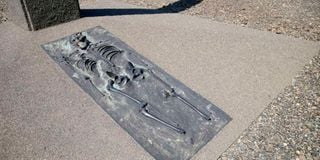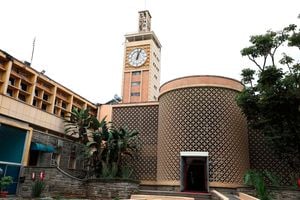
The Turkana Boy monument, at Nariokotome in Turkana North Sub-County. It is a gazetted site.
The village of Nariokotome in Turkana County gained worldwide recognition in 1984 when the fossilised skeletal remains of a 1.6 million-year-old pre-modern human, now known as Turkana Boy, were discovered.
The discovery was made by Kenyan palaeontologist Kamoya Kimeu as part of a team led by Richard Leakey and including officials from the National Museums of Kenya.
The village, located in the Lake Turkana Basin, went on to become a unique palaeoanthropological site for visiting world-renowned palaeoanthropologists, archaeologists, fossil finders and students from various universities around the world who flock to Turkana County to study.

Kamoya Kimeu (right)and Richard Leakey at work. Mr Kamoya was instrumental in the discovery of the Turkana Boy fossil.
The village is characterised by traditional Manyatta houses, indigenous and evergreen trees and a high daytime climate.
Despite the county government's efforts to attract visitors to the village by building a replica of the Turkana Boy monument, residents have raised concerns about the now-forgotten site.
Residents have even been forced to move from their homes so that the area can be fenced off in the hope of building a museum where visitors can see and learn about the discoveries. However, the site has not attracted much tourism.
The Turkana boy's skeleton is kept in a safe room at the National Museums of Kenya in Nairobi, where it is identified as KNM-WT 15000.

A monument of the Turkana Boy at Nariokotome village in Turkana County county where the fossils were discovered.
It recently came into the public eye when Magical Kenya took it to the 2024 Olympics in Paris, France, and displayed it at Kenya House to showcase Kenya as the origin of mankind.
But the Turkana people of Nariokotome village want the government to return the fossils to their ancestral land so that they can benefit directly from the proceeds by funding education, health and water projects.

Ekiru Ewaton and his wife Esekon Lowa who take care of the artistic impression of a fossil skeletal remains of a 1,600,000-year-old pre-modern human now known as the Turkana Boy.
Ms Esekon Lowaa, a resident, said just as the Kenyan government took the Turkana Boy to Paris during the Olympics to showcase Kenya as the epitome of tourism as the home of mankind, it should also bring the fossil back to where it was discovered to boost tourism numbers.
"We have welcomed the county government's move to fence the site in the hope that Turkana Boy, whom we nicknamed 'Brian Ekiru', will be brought back so that tourists can get their money's worth when they visit our village. We only have a replica of the Turkana Boy and people can go without getting reliable information because we don't have a museum and a curator," said Ms Lowaa.
Another resident, Asukuru Esekon, said there had been a decline in visitors to her village, which is about 130km from Lodwar town through Kalokol town.
"We need the county government to invest in hotels, shops, water projects and a college for evolution studies so that our children have opportunities. We also want the government to ensure that we benefit from the revenues from Turkana Boy," said Mr Esekon.
Residents are optimistic that the National Museums of Kenya and the Ministry of Tourism will use the upcoming Turkana Tourism and Cultural Festival to return the fossils to Turkana.
The county tourism department said the festival, also known as Tobon'gulore (Welcome Home), will give visitors an opportunity to learn more about the 'Turkana Boy' among other historical, archaeological, tourism and natural treasures of Turkana that tell the beautiful stories of Turkana, its people, culture and traditions.
During the seventh edition of the festival held in October last year, President William Ruto announced that his administration would support the next edition with a Sh25 million boost and unlock the huge tourism potential of the Turkana Basin.

A police reservist from Nariokotome village watches as visitors admires the Turkana Boy.
Dr Ruto announced plans to ensure that no one needs a visa to visit Kenya for the next edition as archaeologists have made discoveries that the East African savannah was the place where the earliest human ancestors evolved, with Kenya being recognised by pre-history experts, including palaeontologists, as the cradle of humanity.
Dr Ruto: "It was not fair for anybody to be asked for a visa when coming home. Lake Turkana basin to be specific is the site where the oldest remains of human ancestors have been discovered. That is why we have committed to facilitate people all over the world to come home, by providing visas free of charge to everyone coming into our country."
Residents of Nariokotome village are now banking on the proposed Kenya, Home of Human Origins project, whose concept development committee comprises members from various ministries, departments and agencies.
These include the Kenya Defence Forces (KDF), Ministry of Tourism, National Museums of Kenya (NMK), Kenya Tourism Board (KTB), Kenya Wildlife Service (KWS), Turkana County Government and other stakeholders, and has been mandated by the President to research, design, develop, showcase and operationalise the national project.

Some of the participants of the Explore Turkana Tourism Initiative at the Turkana Boy monument.
The committee is exploring the linkages between different tourism products in the county, including the rich cultural heritage of the Turkana people and other communities in the Lake Turkana Basin.
The study will also identify various infrastructural developments that should be put in place to harness the tourism potential of the Lake Turkana Basin, which covers Turkana, Baringo, Marsabit and Samburu counties.
The Home of Human Origins project is a new concept that aims to add a new dimension to Kenya's tourism sector, which is dominated by wildlife and beach tourism, by attracting tourists who want to connect with the origins of mankind.
The project is expected to open up and elevate the Lake Turkana basin that also gas attractions such as the Lothagam North Pillar site which was the first major Later Stone Age fishing settlement discovered in Kenya along Lake Turkana, Kalokol Standing Stones (Namorutunga), Eliye Springs and the Central Island National Park and Kenya at large as a global tourist destination for both social and economic advancement.







